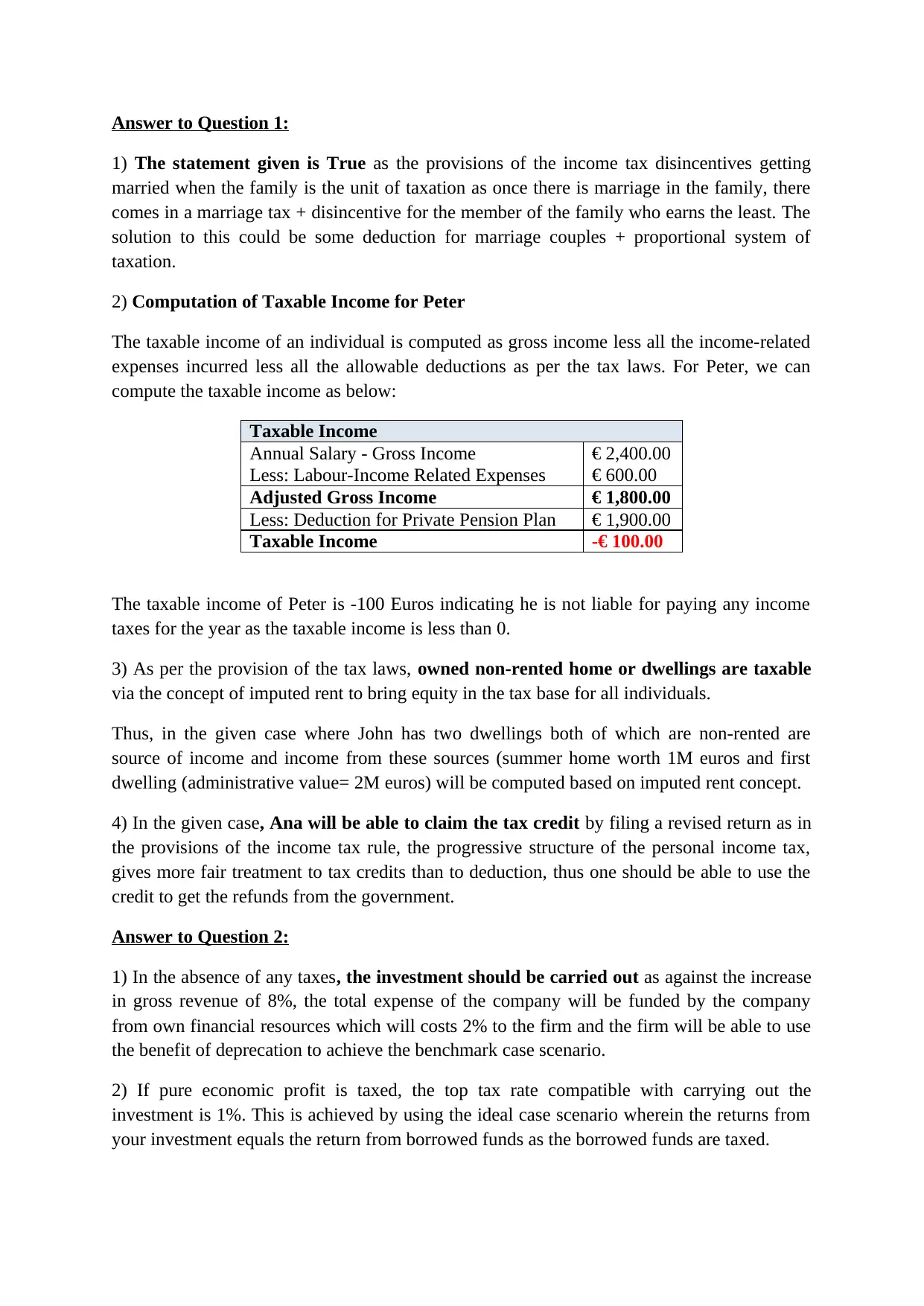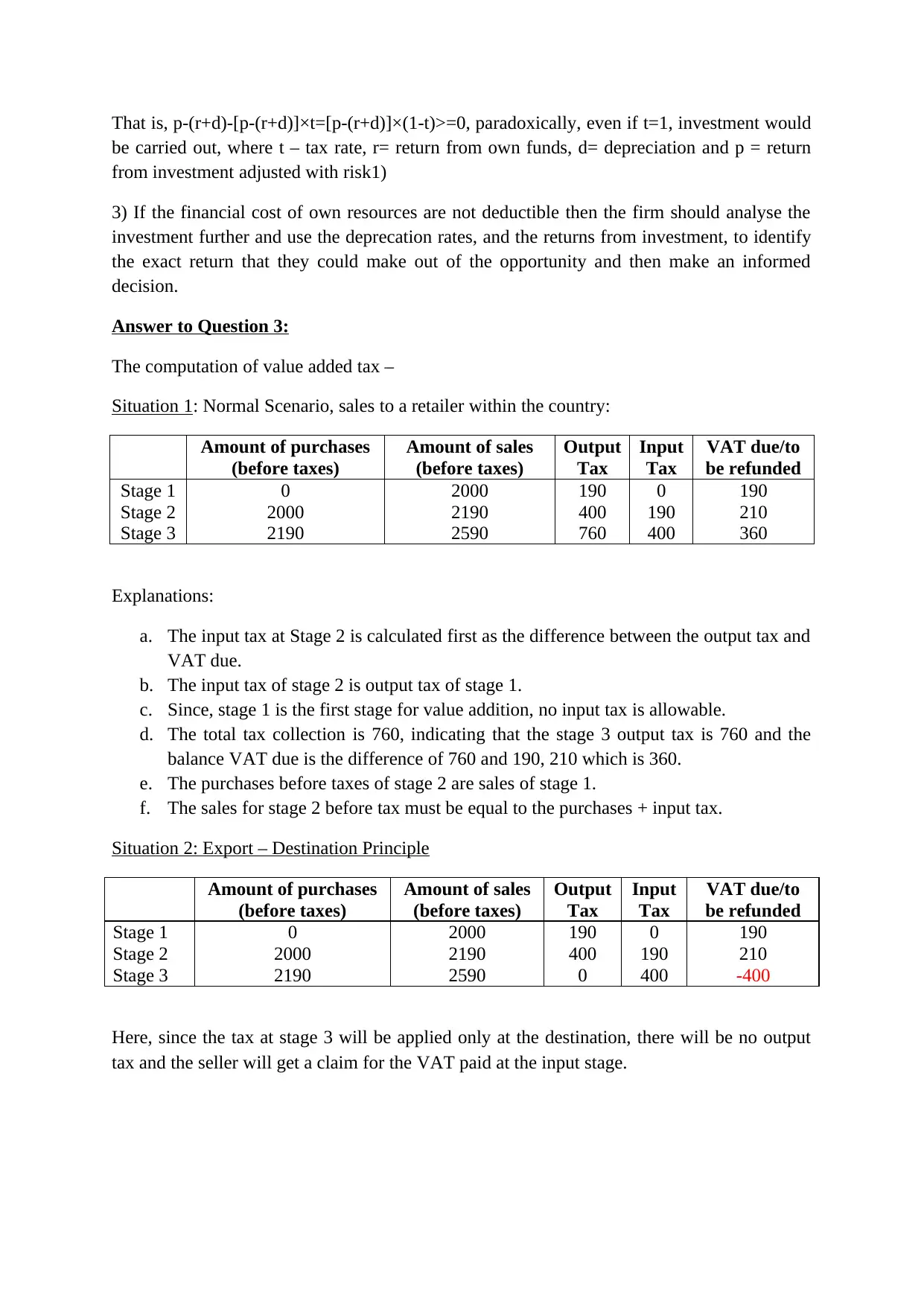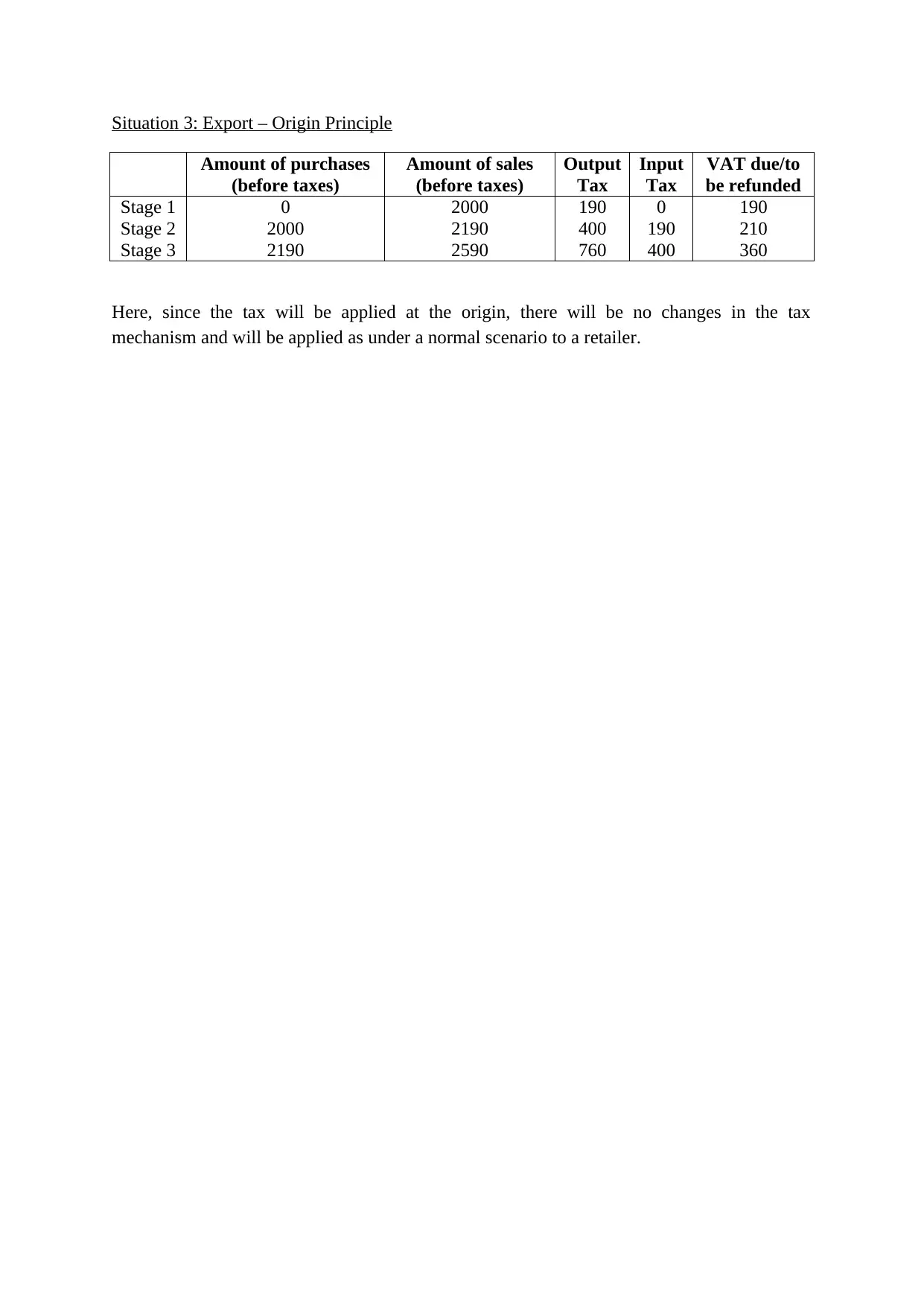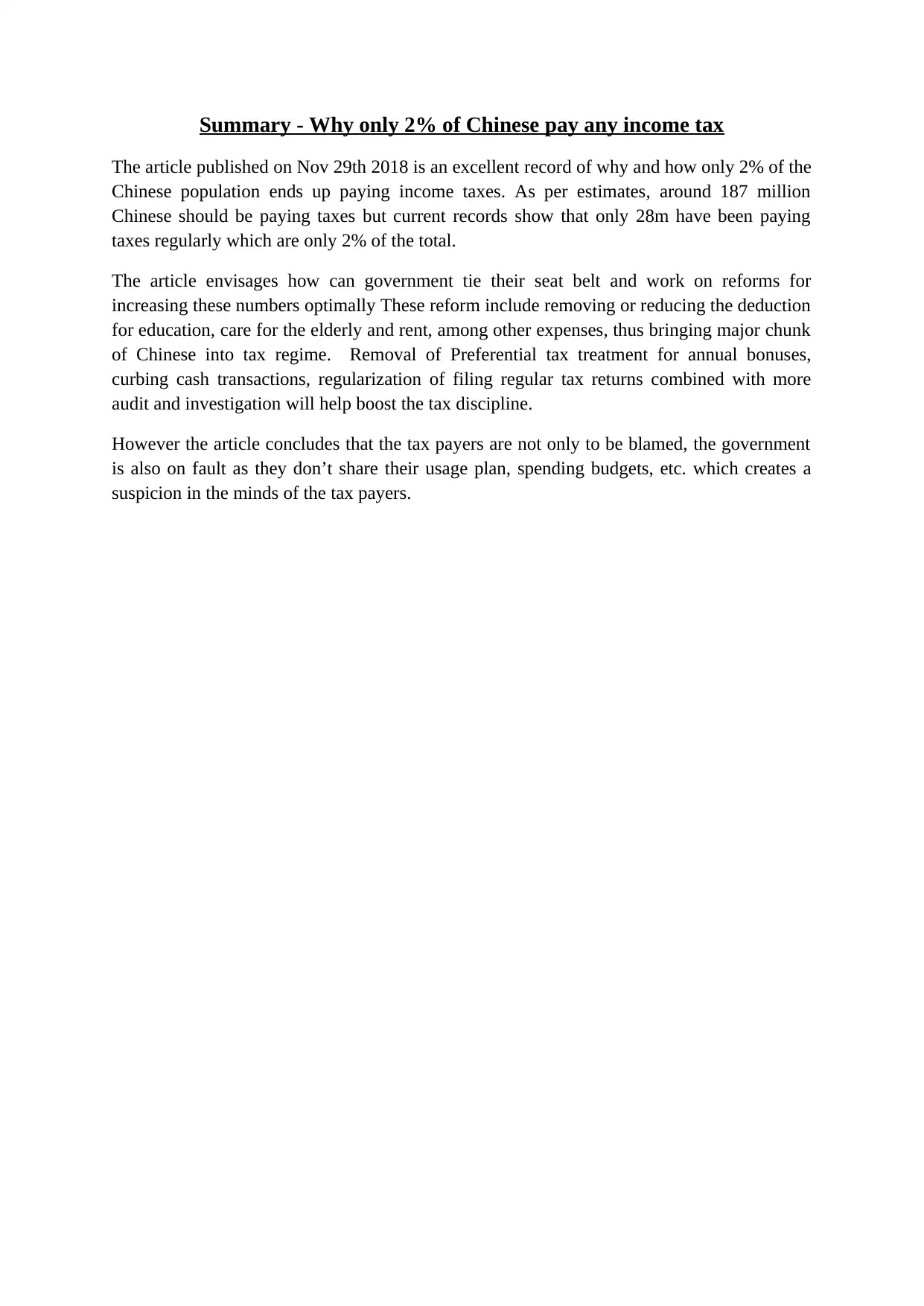Analysis of Income Tax, Corporate Tax, and VAT - Tax Law-II
VerifiedAdded on 2023/04/22
|4
|1147
|379
Homework Assignment
AI Summary
This assignment provides solutions to questions related to personal income tax, corporate income tax, and value-added tax (VAT). It addresses the disincentives of marriage under a proportional income tax system, calculates taxable income for an individual considering deductions and expenses, discusses the taxability of owned non-rented homes through imputed rent, and explains how tax credits can lead to refunds. Furthermore, it analyzes corporate investment decisions in the presence of taxes, including scenarios where economic profit is taxed and where the financial cost of own resources is not deductible. The assignment also includes a detailed computation of VAT under different situations, such as normal sales, exports under the destination principle, and exports under the origin principle. Finally, it summarizes an article discussing why only a small percentage of the Chinese population pays income tax, highlighting potential reforms and issues with government transparency.

Answer to Question 1:
1) The statement given is True as the provisions of the income tax disincentives getting
married when the family is the unit of taxation as once there is marriage in the family, there
comes in a marriage tax + disincentive for the member of the family who earns the least. The
solution to this could be some deduction for marriage couples + proportional system of
taxation.
2) Computation of Taxable Income for Peter
The taxable income of an individual is computed as gross income less all the income-related
expenses incurred less all the allowable deductions as per the tax laws. For Peter, we can
compute the taxable income as below:
Taxable Income
Annual Salary - Gross Income € 2,400.00
Less: Labour-Income Related Expenses € 600.00
Adjusted Gross Income € 1,800.00
Less: Deduction for Private Pension Plan € 1,900.00
Taxable Income -€ 100.00
The taxable income of Peter is -100 Euros indicating he is not liable for paying any income
taxes for the year as the taxable income is less than 0.
3) As per the provision of the tax laws, owned non-rented home or dwellings are taxable
via the concept of imputed rent to bring equity in the tax base for all individuals.
Thus, in the given case where John has two dwellings both of which are non-rented are
source of income and income from these sources (summer home worth 1M euros and first
dwelling (administrative value= 2M euros) will be computed based on imputed rent concept.
4) In the given case, Ana will be able to claim the tax credit by filing a revised return as in
the provisions of the income tax rule, the progressive structure of the personal income tax,
gives more fair treatment to tax credits than to deduction, thus one should be able to use the
credit to get the refunds from the government.
Answer to Question 2:
1) In the absence of any taxes, the investment should be carried out as against the increase
in gross revenue of 8%, the total expense of the company will be funded by the company
from own financial resources which will costs 2% to the firm and the firm will be able to use
the benefit of deprecation to achieve the benchmark case scenario.
2) If pure economic profit is taxed, the top tax rate compatible with carrying out the
investment is 1%. This is achieved by using the ideal case scenario wherein the returns from
your investment equals the return from borrowed funds as the borrowed funds are taxed.
1) The statement given is True as the provisions of the income tax disincentives getting
married when the family is the unit of taxation as once there is marriage in the family, there
comes in a marriage tax + disincentive for the member of the family who earns the least. The
solution to this could be some deduction for marriage couples + proportional system of
taxation.
2) Computation of Taxable Income for Peter
The taxable income of an individual is computed as gross income less all the income-related
expenses incurred less all the allowable deductions as per the tax laws. For Peter, we can
compute the taxable income as below:
Taxable Income
Annual Salary - Gross Income € 2,400.00
Less: Labour-Income Related Expenses € 600.00
Adjusted Gross Income € 1,800.00
Less: Deduction for Private Pension Plan € 1,900.00
Taxable Income -€ 100.00
The taxable income of Peter is -100 Euros indicating he is not liable for paying any income
taxes for the year as the taxable income is less than 0.
3) As per the provision of the tax laws, owned non-rented home or dwellings are taxable
via the concept of imputed rent to bring equity in the tax base for all individuals.
Thus, in the given case where John has two dwellings both of which are non-rented are
source of income and income from these sources (summer home worth 1M euros and first
dwelling (administrative value= 2M euros) will be computed based on imputed rent concept.
4) In the given case, Ana will be able to claim the tax credit by filing a revised return as in
the provisions of the income tax rule, the progressive structure of the personal income tax,
gives more fair treatment to tax credits than to deduction, thus one should be able to use the
credit to get the refunds from the government.
Answer to Question 2:
1) In the absence of any taxes, the investment should be carried out as against the increase
in gross revenue of 8%, the total expense of the company will be funded by the company
from own financial resources which will costs 2% to the firm and the firm will be able to use
the benefit of deprecation to achieve the benchmark case scenario.
2) If pure economic profit is taxed, the top tax rate compatible with carrying out the
investment is 1%. This is achieved by using the ideal case scenario wherein the returns from
your investment equals the return from borrowed funds as the borrowed funds are taxed.
Paraphrase This Document
Need a fresh take? Get an instant paraphrase of this document with our AI Paraphraser

That is, p-(r+d)-[p-(r+d)]×t=[p-(r+d)]×(1-t)>=0, paradoxically, even if t=1, investment would
be carried out, where t – tax rate, r= return from own funds, d= depreciation and p = return
from investment adjusted with risk1)
3) If the financial cost of own resources are not deductible then the firm should analyse the
investment further and use the deprecation rates, and the returns from investment, to identify
the exact return that they could make out of the opportunity and then make an informed
decision.
Answer to Question 3:
The computation of value added tax –
Situation 1: Normal Scenario, sales to a retailer within the country:
Amount of purchases
(before taxes)
Amount of sales
(before taxes)
Output
Tax
Input
Tax
VAT due/to
be refunded
Stage 1 0 2000 190 0 190
Stage 2 2000 2190 400 190 210
Stage 3 2190 2590 760 400 360
Explanations:
a. The input tax at Stage 2 is calculated first as the difference between the output tax and
VAT due.
b. The input tax of stage 2 is output tax of stage 1.
c. Since, stage 1 is the first stage for value addition, no input tax is allowable.
d. The total tax collection is 760, indicating that the stage 3 output tax is 760 and the
balance VAT due is the difference of 760 and 190, 210 which is 360.
e. The purchases before taxes of stage 2 are sales of stage 1.
f. The sales for stage 2 before tax must be equal to the purchases + input tax.
Situation 2: Export – Destination Principle
Amount of purchases
(before taxes)
Amount of sales
(before taxes)
Output
Tax
Input
Tax
VAT due/to
be refunded
Stage 1 0 2000 190 0 190
Stage 2 2000 2190 400 190 210
Stage 3 2190 2590 0 400 -400
Here, since the tax at stage 3 will be applied only at the destination, there will be no output
tax and the seller will get a claim for the VAT paid at the input stage.
be carried out, where t – tax rate, r= return from own funds, d= depreciation and p = return
from investment adjusted with risk1)
3) If the financial cost of own resources are not deductible then the firm should analyse the
investment further and use the deprecation rates, and the returns from investment, to identify
the exact return that they could make out of the opportunity and then make an informed
decision.
Answer to Question 3:
The computation of value added tax –
Situation 1: Normal Scenario, sales to a retailer within the country:
Amount of purchases
(before taxes)
Amount of sales
(before taxes)
Output
Tax
Input
Tax
VAT due/to
be refunded
Stage 1 0 2000 190 0 190
Stage 2 2000 2190 400 190 210
Stage 3 2190 2590 760 400 360
Explanations:
a. The input tax at Stage 2 is calculated first as the difference between the output tax and
VAT due.
b. The input tax of stage 2 is output tax of stage 1.
c. Since, stage 1 is the first stage for value addition, no input tax is allowable.
d. The total tax collection is 760, indicating that the stage 3 output tax is 760 and the
balance VAT due is the difference of 760 and 190, 210 which is 360.
e. The purchases before taxes of stage 2 are sales of stage 1.
f. The sales for stage 2 before tax must be equal to the purchases + input tax.
Situation 2: Export – Destination Principle
Amount of purchases
(before taxes)
Amount of sales
(before taxes)
Output
Tax
Input
Tax
VAT due/to
be refunded
Stage 1 0 2000 190 0 190
Stage 2 2000 2190 400 190 210
Stage 3 2190 2590 0 400 -400
Here, since the tax at stage 3 will be applied only at the destination, there will be no output
tax and the seller will get a claim for the VAT paid at the input stage.

Situation 3: Export – Origin Principle
Amount of purchases
(before taxes)
Amount of sales
(before taxes)
Output
Tax
Input
Tax
VAT due/to
be refunded
Stage 1 0 2000 190 0 190
Stage 2 2000 2190 400 190 210
Stage 3 2190 2590 760 400 360
Here, since the tax will be applied at the origin, there will be no changes in the tax
mechanism and will be applied as under a normal scenario to a retailer.
Amount of purchases
(before taxes)
Amount of sales
(before taxes)
Output
Tax
Input
Tax
VAT due/to
be refunded
Stage 1 0 2000 190 0 190
Stage 2 2000 2190 400 190 210
Stage 3 2190 2590 760 400 360
Here, since the tax will be applied at the origin, there will be no changes in the tax
mechanism and will be applied as under a normal scenario to a retailer.
⊘ This is a preview!⊘
Do you want full access?
Subscribe today to unlock all pages.

Trusted by 1+ million students worldwide

Summary - Why only 2% of Chinese pay any income tax
The article published on Nov 29th 2018 is an excellent record of why and how only 2% of the
Chinese population ends up paying income taxes. As per estimates, around 187 million
Chinese should be paying taxes but current records show that only 28m have been paying
taxes regularly which are only 2% of the total.
The article envisages how can government tie their seat belt and work on reforms for
increasing these numbers optimally These reform include removing or reducing the deduction
for education, care for the elderly and rent, among other expenses, thus bringing major chunk
of Chinese into tax regime. Removal of Preferential tax treatment for annual bonuses,
curbing cash transactions, regularization of filing regular tax returns combined with more
audit and investigation will help boost the tax discipline.
However the article concludes that the tax payers are not only to be blamed, the government
is also on fault as they don’t share their usage plan, spending budgets, etc. which creates a
suspicion in the minds of the tax payers.
The article published on Nov 29th 2018 is an excellent record of why and how only 2% of the
Chinese population ends up paying income taxes. As per estimates, around 187 million
Chinese should be paying taxes but current records show that only 28m have been paying
taxes regularly which are only 2% of the total.
The article envisages how can government tie their seat belt and work on reforms for
increasing these numbers optimally These reform include removing or reducing the deduction
for education, care for the elderly and rent, among other expenses, thus bringing major chunk
of Chinese into tax regime. Removal of Preferential tax treatment for annual bonuses,
curbing cash transactions, regularization of filing regular tax returns combined with more
audit and investigation will help boost the tax discipline.
However the article concludes that the tax payers are not only to be blamed, the government
is also on fault as they don’t share their usage plan, spending budgets, etc. which creates a
suspicion in the minds of the tax payers.
1 out of 4
Related Documents
Your All-in-One AI-Powered Toolkit for Academic Success.
+13062052269
info@desklib.com
Available 24*7 on WhatsApp / Email
![[object Object]](/_next/static/media/star-bottom.7253800d.svg)
Unlock your academic potential
Copyright © 2020–2025 A2Z Services. All Rights Reserved. Developed and managed by ZUCOL.




